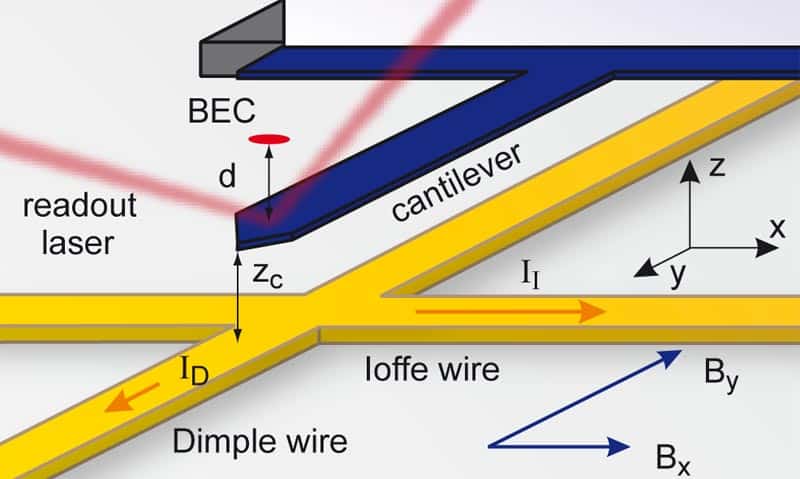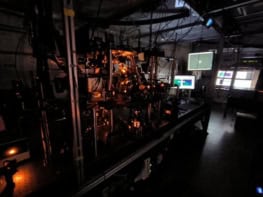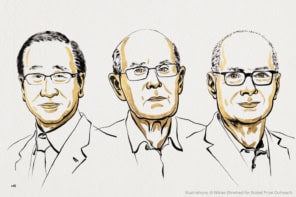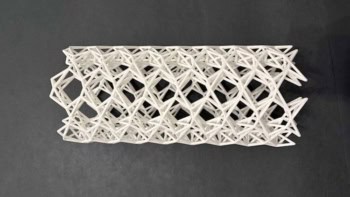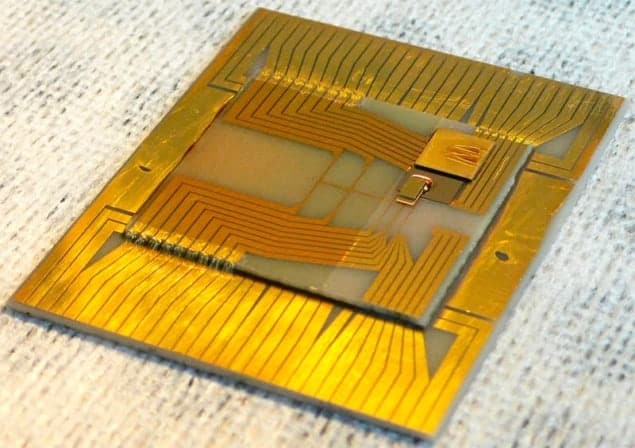
Physicists in Germany and France have coupled a Bose–Einstein condensate (BEC) of ultracold atoms to the vibrations of a mechanical oscillator for the first time. Although the oscillator is relatively large and obeys the laws of classical physics, the team believes that the technique could be applied to quantum oscillators. If so, it could lead to the development of BEC-oscillator quantum-computing devices or to new techniques for measuring very small magnetic or other forces.
Bose–Einstein condensates are formed when identical atoms with integer spin are cooled until all the atoms are in the same quantum state. In the new work, carried out by Philipp Treutlein and colleagues at the Ludwig-Maximilians University in Munich and the Kastler Brossel Laboratory in Paris, a tiny magnetic microtrap known as an “atom chip” was used to cool about 2000 rubidum-87 atoms to below 1 µK. Roughly 3 cm across, the chip uses metal wires just 50 µm wide to create magnetic fields that trap the atoms.
Treutlein’s team began by creating a BEC with a radius of about 300 nm that was then guided to within 1 µm of the surface of the mechanical oscillator. The oscillator, which is integrated within the chip, is an off-the-shelf cantilever for an atomic-force microscope. It is about 200 µm long and 450 nm thick, has a natural frequency of vibration of 10 kHz and is driven using a piezoelectric device.
Sloshing about
Atoms in the BEC interact with the oscillator via the Casimir–Polder force – an attractive force between an atom and a surface that arises from quantum fluctuations in the vacuum. The BEC has a spectrum of vibrational modes, the simplest of which involves the atoms moving back and forth in the trap like water sloshing in a tilted bowl. The frequencies of the modes can be changed by adjusting the size of the trap.
When the frequency of one of the BEC modes matches the frequency of the oscillator, the atoms gain enough energy to escape the trap. Treutlein and colleagues detect these resonances by keeping a BEC next to the oscillator for several milliseconds and then moving it away to count the number of atoms that remain. If the frequencies do not match, hundreds of atoms remain, whereas tens of atoms are left at resonance.
Towards quantum-coherent coupling
By repeating this process for BECs trapped under a number of different conditions the team was able to identify several different vibrational modes. Because these resonances are very sensitive to external fields, such a device could be used as a tool for measuring magnetic and other fields.
A remarkable aspect of the experiment is that the cantilever is at room temperature, whereas the BEC remains near absolute zero. This is possible, according to team member David Hunger, because thermal fluctuations in the cantilever (other than the fundamental vibrational mode) do not resonate with the BEC.
A downside of this temperature difference, however, is that the oscillator is a classical – rather than a quantum – entity and therefore cannot be coupled quantum-coherently with the BEC. Such coupling could allow quantum information to be transferred to the BEC, where it could be stored for a relatively long time because the BEC is very well isolated from the surrounding environment. The oscillator could also be coupled coherently to light or electrons, thereby offering a way of reading and writing the quantum information.
Hunger told physicsworld.com that one way of achieving quantum coupling is to use a very small oscillator such as a carbon nanotube that is chilled to ultracold temperatures. The team is also exploring the use of extremely thin silicon nitride membranes than could interact with a BEC via quantum back-action.
Klemens Hammerer of the University of Innsbruck believes that Hunger, Treutlein and colleague’s work represents an important step forward in the use of ultracold atoms to study mechanical systems. “This experiment clearly demonstrates the possibility to use ultracold atomic systems as diagnostic tools and high-precision sensors, this is a very promising route of research,” he said.
The work is described in Phys. Rev. Lett. 104 143002.
